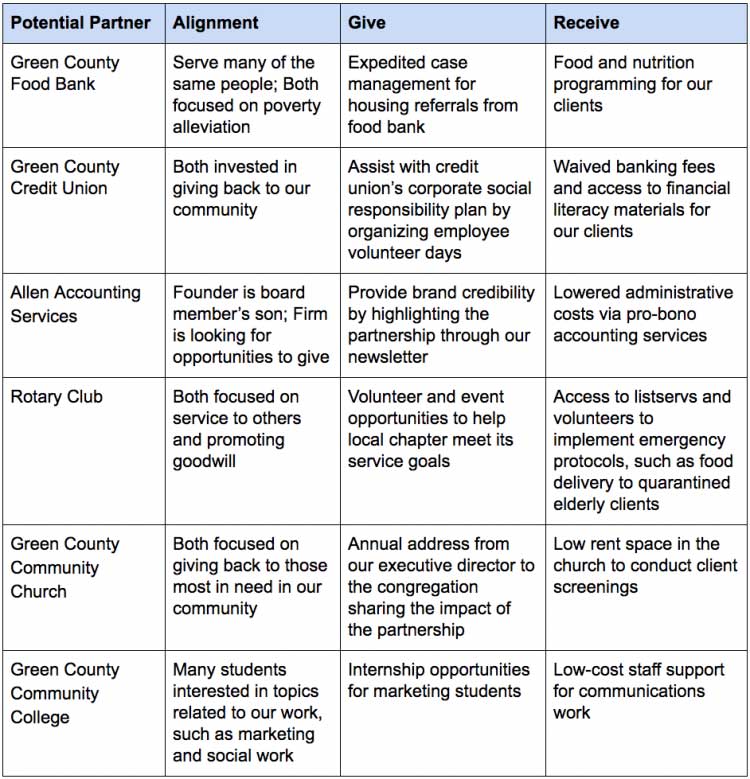How to Create and Digitize Local Partnerships for Your Nonprofit

Request a Demo
Learn how top nonprofits use Classy to power their fundraising.
There’s a saying that goes, “Do what you do best and partner for the rest.” As a nonprofit, you’re tasked with creating the largest impact for your mission with each dollar spent. If you do this alone, you may end up crunched for time and resources, creating a scarcity mindset.
A scarcity mindset can lead to lowered cognitive capacity, making it hard for you and your team to advance your mission. Partnering with local entities like town councils, churches, schools, and community centers can help take pressure off your staff in different areas so they can focus on the most important skills and abilities they bring to your organization.
As a general best practice, partnerships should always be part of your nonprofit’s strategy. They’re especially relevant during times of crisis, like the current coronavirus pandemic.
While you might be working from home and moving your nonprofit’s services to a virtual platform, you shouldn’t let that stop the spirit of finding your next great local partnership. Instead, pivot your mindset to pursue these partnerships through digital means.
Below, we talk about how you can grow your nonprofit by using virtual strategies to tap into local partnerships with businesses, clubs, organizations, and more.
Free Resource: The Guide to Pitching Corporate Sponsors
Identify the Local Partnerships That Will Most Benefit Your Nonprofit
Eighty-five percent of organizations report that finding strategic partnerships is essential to their operations. The key word here is “strategic,” where your partnerships are heavily evaluated and chosen based upon what your goals are and how they align with the interests of your partner.
Where partnerships with big corporations may be focused on large event sponsorships or capital campaigns, local partnerships are often community-oriented. Further, they can connect to a variety of your organization’s operations, from fundraising and volunteerism to service delivery and administrative support.
Before you can identify candidates for local partnerships, think about what you need from one, such as:
- Emergency response support
- Lower administrative costs
- Ability to offer a wider range of services
Next, think about what you can provide in return for the partnership, such as:
- Increased brand credibility
- Opportunities for employee volunteerism or fundraising
- A shared services model with a similar nonprofit
For example, let’s say you operate a program that identifies housing for people experiencing homelessness. Beyond their housing needs, your clients also face food insecurity and you want to be able to provide them access to proper nutrition.
Through a partnership with a local food bank, you could offer this additional service. In return, you could give the food bank expedited case management services for any clients they refer to you who are in need of housing.
Partnering with another nonprofit is just one form of a local partnership. Once you’ve identified what you need and what you can offer in a local partnership, make a list of all the potential partners in your community. These could include:
- Local businesses
- Civic groups
- Faith communities
- Schools and universities
- Sports clubs
Now, looking at each potential partner you identified, take notes on where your missions align and what you might be able to give and receive in the partnership. Using the example from above, your list might look like this:

Digitize Your Outreach and Engagement With Local Partners
You may have formerly approached outreach for your local partnerships by tabling at workplace giving days or other community service events, attending local meetings of different civic groups, or grabbing coffee with a local business owner. When in-person engagement isn’t an option, there are a variety of tools to keep your community conversations going while maintaining social distance. Some options include:
Conference Calls
A phone call is a quick, easy way to share your story with a potential local partner. If you need to have multiple people on the line, there are many low-cost conference calling services available, such as FreeConferenceCall.com or join.me.
Phone calls work for outreach to partners you’ve never met, and those you’ve already been in talks with. If you’ve already connected with this potential partner before, now is the time to discuss moving forward with the partnership.
If it’s your first time reaching out to this prospective partner, cold calling them could catch them off-guard. You should consider softer ways of introducing them to your nonprofit first, such as email, where you can send your elevator pitch. Use that touchpoint to schedule a time for a call.
Video Chat
Programs like Google Hangouts, Zoom, Skype, WebEx, or GoToMeeting offer the opportunity for one-on-one or group meetings where everyone can see and hear each other from their respective locations. These options are ideal for meetings early on with your prospective partner because they limit multi-tasking and let participants read each other’s body language to improve communication and establish stronger relationships.
If you’re using video chat, make sure everyone has a strong enough internet connection for the number of participants. Encourage participants to wear headsets to limit echoing and background noise on the audio. Since you can all see each other, you can also incorporate a fun icebreaker, such as introducing your pets if you work from home or showing a favorite photo from your last vacation.
Social Media
Follow your potential local partner on Twitter, Instagram, Facebook, or any other platform where they’re active and comment on or re-share their posts. This gives you a chance to see if they’re sharing content that aligns with your goals. As you interact with them on social media, it also encourages them to look into your organization.
Once you’ve established a connection with your potential partner via social media, you can send them a direct message to share the value you’ve found in engaging with them and set up a time for a call or video chat to talk further about a formal partnership.
Email is an easy way to begin your outreach to a local partner. Emails under 200 words have the highest response rate, so keep your outreach email brief, easy to read, and with a clear ask, such as setting up a time to discuss a partnership further. Include links to additional information about your nonprofit. This gives your partner time to digest your ask and look into your organization more before responding.
People are busy and emails can get buried in inboxes, so set yourself a reminder to follow-up with them if you haven’t heard back within two weeks of sending.
Get Creative to Grow and Maintain Your Local Partnership
Once you’ve agreed to form a local partnership, the work begins to grow and maintain that relationship. Between 50% and 80% of business partnerships fail, which underscores the need to be thoughtful about your partnership from the start.
As you grow your partnership, remember to:
Have a clear definition of your shared goals, and document them in writing.
Using SMART goals (specific, measureable, attainable, relevant, and time bound) can ensure you and your partner are on the same page.
EXAMPLE – Using the previous scenario of the housing provider and food bank, a partnership goal could be: Our nonprofit will provide expedited case management for up to 25 referrals from Green County Food Bank for FY 2020. In exchange, Green County Food Bank will host quarterly nutrition classes for our clients in FY 2020 and provide them with access to the food pantry.
Know how you’ll communicate about your goals.
Along with writing down your goals, write down agreements on how you’ll communicate within your partnership. Having these strategies in place gives you something to return to if you need to make course corrections during the partnership.
EXAMPLE – The communication agreements you write with your partner could include:
- We will meet once per month to check-in on progress toward our goals. If we are behind schedule, we will determine action steps to either adjust the schedule or catch up.
- In each meeting, we will begin with an icebreaker and opportunity to get to know each other on a more personal level.
- Between meetings, we will be responsive to one another via email if any issues or new ideas arise.
Get creative to keep the spirit of your partnership moving forward.
After your partnership is established, set aside time in your check-in meetings to share new ideas and explore additional options for growing your partnership. Keeping things fun and innovative will help to keep everyone excited about the partnership, even from a virtual setting.
EXAMPLE – Using the digital platforms with which you’ve grown your partnership, you and your local partner could pair up for a big virtual event. Using tools like Facebook Live, you could host a virtual auction or fundraising gala. You could also host an educational webinar series to teach more community members about your mission.
Digitize Your Local Partnerships to Thoughtfully Expand Your Nonprofit’s Reach
With constantly changing environments, including more people working remotely, it takes creativity and effective use of available technology to keep expanding the reach of your nonprofit. Using digital tools is a great way to pursue local partnerships for the benefit of both your nonprofit and your community at large.

The Guide to Pitching Corporate Sponsors
Subscribe to the Classy Blog
Get the latest fundraising tips, trends, and ideas in your inbox.
Thank you for subscribing
You signed up for emails from Classy
Request a Demo
Learn how top nonprofits use Classy to power their fundraising.
 Explore Classy.org
Explore Classy.org 

